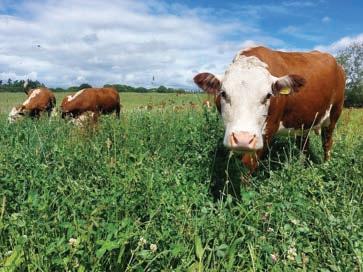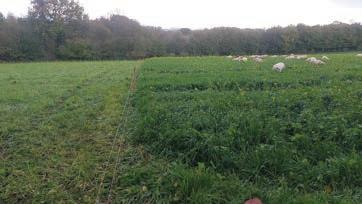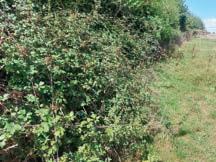
12 minute read
Regenerative Farming Methods Richard Thomas
Regenerative Farming Methods
- Richard Thomas
Advertisement
‘Regenerative farming methods’ is an adventurous title for this article, but I will do my best to navigate my way through the issues and explain why now, more than ever, change is needed and why the conservation lobby needs to work with agriculture to make positive change for all. I started my journey into ‘regenerative agriculture’ around eight years ago. I clearly remember being in the sheep shed, mid-way through lambing, at around nine pm, suckling lambs, feeling tired and wondering why I was doing that particular job, at that particular time, when to coin a phrase, the newly born lamb only has one job. To be born, stand up and suckle its mother. There was probably a multitude of reasons why we had an issue with some of our lambs at that time, but it set in train a period of thinking and learning for me to bring us much closer to farming with nature. I now prefer the term ‘agroecology’, because it seems the phrase ‘regenerative agriculture’ has been highjacked by almost everyone, from multinational food production companies to agribusinesses. By its very nature regenerative cannot be defined and therefore not certified, it is just a set of principles that we will at some point have to follow, in order to try and produce healthy food from healthy soil. It is probably not overstating the situation to suggest that modern, western agriculture is underpinned by fossil fuels and in particular nitrogen fertiliser. In most of those farming systems nitrogen fertiliser is the main emitter of greenhouse gases, notably carbon and nitrous oxide. Now I don’t want to get into a debate about what gases, how long they last in our atmosphere and how bad this all is for the future of the planet, but I think few people can debate against the need to reduce our reliance on fossil fuels. The elephant in the room, however, is that of food production. The commonly quoted statistic is that several billion people (between one and four, depending what reference you use) are alive today because of the work of Norman Borlaug and the so called ‘Green Revolution’. However, whilst the ethical discussion around that is fraught with complication, we all know the current situation is unsustainable, never mind regenerative. At some point the change will come because not only will energy and resources be a limiting factor, our ecological and biodiversity crisis will continue to spiral. I remember reading an article about Chinese apple farmers having to hand pollinate their trees, because of the decline of bees. How have we got to a point where that is even a thing? So, bringing things a bit closer to home, how do we get from the current model to one that is more sustainable and hopefully regenerative? Well, if we follow the principles of regenerative agriculture and try to move towards a place where our farm systems rely less on fossil fuels, I think we are heading in the right direction. They are: do not disturb the soil, keep the soil surface covered, keep living roots in the soil, introduce diversity (plants and animals) and bring grazing animals back to the land. There are people who are stuck in the mistaken belief that everything will be ok if we get rid of all the cows. I think it helps at this juncture to quote a graphic, or perhaps ‘meme’, I saw on social media recently. There was a picture of a cow eating grass and a few lines of text saying something along the lines of ‘imagine thinking cows eating grass is killing the
planet, cows eating grass is the planet’. A second quote, from Nicolette Hahn Niman a former vegetarian and the author of ‘Defending Beef’, is appropriate here too. “It’s not the cow, it’s the how”. Like so many things, the devil is in the detail and it is the system which those cows are in that counts. For millions of years the great grasslands of this planet evolved in the context of the symbiotic relationship between the ruminant animal and the grass. You simply cannot have one without the other. It is quite typical of humans, because we think we are so clever, to now blame the cow for the problem we have created ourselves by poor management. After all, the cows managed quite well thank you very much before we came along and stuffed it all up.
Eight years on, my father and I are trying to get as close as we can to running our small farm in an agroecological and regenerative fashion. We do not use any artificial fertiliser, use a very small amount of herbicide on our small arable acreage and, where possible (which is most of the time), move our animals every day, trying to mimic the movement of the great herds across the great expanse of grasslands of the Midwest of the US, or the Serengeti. It is a bold claim, but perhaps the most powerful tool we have in a grassland situation is that of rest.
Rotational grazing underpins almost everything we do here and it is not a new concept. Most dairy farmers have been using some kind of grass management for decades. Strip grazing, where an electric fence is moved in front of the cows every day, or after every milking has been a common technique for a long time. The seminal work on grass
Cows grazing on the farm
management in a temperate climate was published in 1959. Written by a Frenchman called Andre Voisin, his work set the standard that everyone else works to. Prior to him a Scottish agriculturalist called James Anderson wrote about daily rotation of cattle in 1777. ‘There are no (or very few) new ideas under the sun’! The difference is that in 1777, animals moving daily in small fields, or paddocks, were contained by stone walls and probably watered by lots of small bodies of running water. Today we have the luxury of polywire for electric fencing and polypipe for water. The psychological barrier provided by an electric fence gives a really easy and hugely flexible way of controlling how much area is available to the animals for any given period of time. I could go into a bit more detail here, but suffice to say that using these two pieces of technology we can move animals through our fields and use the back fence, that is to say the one behind them to make sure they do not re-graze the grass as it grows, before it is able to fully recover.
That principle of recovery, or rest, is the key one. A grass plant is said to be able to be regrazed after three days. So, moving twice a week is sufficient. We try to move every day, or every second day, depending on the field and the group of animals. It is perhaps surprising how quickly the animals learn that they are moved everyday and I think we have built up a level of trust with them. Once they are on a daily move, they understand that they will move to fresh grass and are actually quite pleased about that! So, it is almost more important where the animals are not, than where they are and that is where making space for nature and the role of our farm ecosystem is really important. We have a rotation length, or rest period of around 30 days in the spring, increasing to 45 and then 60 days in summer time. If it is particularly dry, meaning slower growth, we try to push the rest period out even further, towards 90 or 100 days. It is not always an easy concept to get your head around, but by building longer rest periods in, we can make the most of the sunshine that hits the farm every day and remove the need for synthetic fertiliser. Those

Electric fencing used as a tool to move livestock around pastures
of you interested in farmland birds will know that birds like the skylark need around seven weeks being undisturbed to be able to hatch and rear a brood of chicks. Seven weeks being fifty days means that we are building in a rest period that is helping our farmland birds as well as our grassland production. So, leaving these longer rest periods as well as employing shorter duration grazing events means that there will often be forage left behind. We do not want to eat all the grass that is available in every paddock, because the process that makes all this possible, photosynthesis, needs chlorophyll. The old phrase is grass grows grass, so we try to leave some forage behind. By doing that we not only help the grass recover quicker, some will not be eaten at all and have an opportunity to go to seed. We also leave some areas ungrazed all together, along with our three metre wide wildlife corridors, or laid hedgerows. This provides food and habitat for other small birds and mammals. We do make silage for our cattle to eat in winter, but we try to limit that to one or two cuts. We make hay too, and try, where possible to allow the field to go to seed before it is cut. We want the grasses and herbs to go to seed to regenerate our pastures, but we also recognise that a longer period of undisturbed growth is important to creatures like voles and mice. I was moving a group of cattle last autumn into a field with quite tall grass. As the cattle moved in, the insects got up and as they rose into the air we were joined by a host of swallows, swooping and diving for the feast. It must have been the last day for the swallows before they flew south for the winter, so that was probably why there were so many. We lost count at around 150. Nature has a gain from this kind of grazing and there is also a gain for the farmer too. We do not need to use chemical fly repellent on our cattle, because we are moving the cattle daily: they are rarely near the hatching flies and our wildlife is taking care of them for us. That is how nature designed the system to work, if only we can work with it to benefit the farm and the wildlife.
There are many other examples of how we can design our farms to operate as an ecosystem, with our wildlife. Dung beetles are a very important part of any ecosystem, and yet they are largely ignored. Unfortunately some of the anthelmintic wormers commonly used by farmers can kill them and other soil micro fauna. Animal welfare has to be a large consideration when deciding whether or not to treat sheep and cattle, but if we change the way we graze and test the faeces of the animals, we can see if using those wormers is necessary. If the dung beetles process the dung of the animals, we don’t need to harrow the fields to break down the manure, we have fewer flies, so we don’t need to use fly treatment and the really valuable nutrients that the ruminant animals provide as a by-product of their grazing go back into the soil. So, you see, it is all one big cycle. Integrating trees and diverse pastures back into the farmed landscape can benefit all stakeholders. Farmers, livestock, wildlife and the public. It is a bit like Pandora’s Box, once you have opened it and you understand how farming and nature can work together, you really cannot go back. We have seen numbers of birds and mammals increase here over the past few years and we are starting to monitor that. Unfortunately our hares have been victims of yobs and their dogs, but field mice and voles are doing well, along with the skylarks and the yellowhammers. I am fairly sure that we have at least two family pairs of the latter and surely more will get established as we plant more hedges and provide more habitat and food. I saw a snipe in early autumn in one of our permanent pasture fields, something I don’t see very often. We are laying hedges on something like a twenty year rotation, double fencing and only flail trimming a few hedges sparingly to encourage them to bush out. We are planting trees

Tree planting (left) and bushy hedgerows (right) all contribute to the farm ecosystem and guarding the ones planted by our wildlife: jays and squirrels do have a role after all! We leave some brash behind for habitat when we prune a tree or lay a hedge and we have some fenced-out wild areas that are left alone. We leave standing dead wood in our woodland and orchards to provide habitat for our wildlife and I can confidently say we have quite a good woodpecker population, green and great spotted. Like many arable farmers we have some wild bird strips along our hedges. These diverse planted areas have many small and large seeds that will help to fill the hungry gap our farmland wildlife has through what can be a long winter. Our old ‘standard’ apple orchards are a great haven for wildlife too. We graze the grass under the trees and pick the apples, but some are always left behind. If you walk through the orchards at dusk you can see the bats flying around and often hear owls calling to each other. We also have quite a lot of bramble encroachment into the wilder areas of our woodlands and the hill fort which sits in the centre of the farm. Not only do we get the pleasure of some very tasty blackberries, they provide quiet habitat for all sorts of wildlife. It is that diverse mixture of habitats right across the farm that allows the wildlife to flourish and us to work in a land-sharing way. Of course, we need to remain profitable and I do not see why that should be such a bad thing, we all have a family and bills to pay. By working with our farm, our land, our wildlife, our farm ecosystem, I believe we can farm in an agroecological manner. Many farms are heading in a similar direction. After all the inflationary pressures we are all facing at the moment are certainly no less in agriculture. My call to you as conservationists? Perhaps you can get involved with a local project on a local farm, help to put some guards around some tree saplings, plant some trees, lay a hedge, do a bird or butterfly count or a plant species count in a hay meadow. We can improve our farm environment and we can only do that if we work together.










